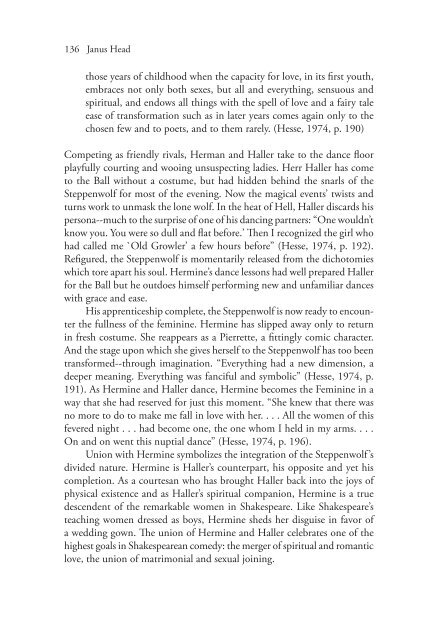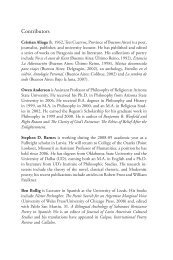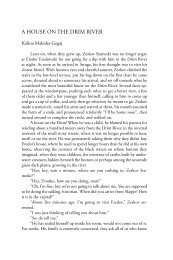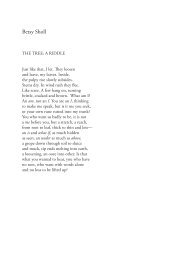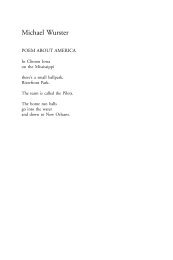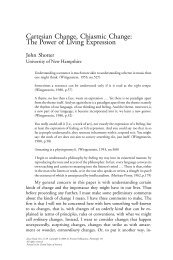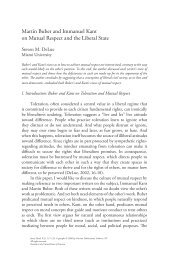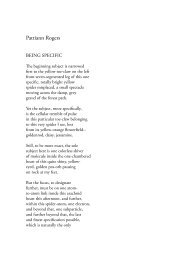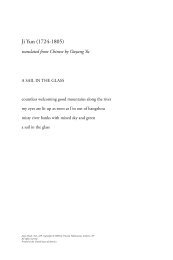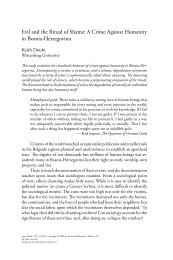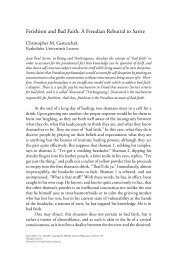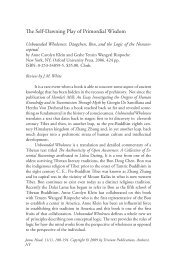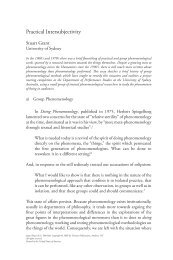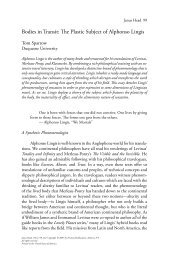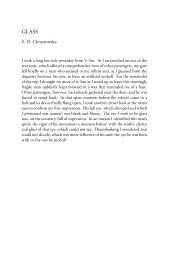Hesse's Steppenwolf: A Comic-Psychological ... - Janus Head
Hesse's Steppenwolf: A Comic-Psychological ... - Janus Head
Hesse's Steppenwolf: A Comic-Psychological ... - Janus Head
You also want an ePaper? Increase the reach of your titles
YUMPU automatically turns print PDFs into web optimized ePapers that Google loves.
136 <strong>Janus</strong> <strong>Head</strong><br />
those years of childhood when the capacity for love, in its first youth,<br />
embraces not only both sexes, but all and everything, sensuous and<br />
spiritual, and endows all things with the spell of love and a fairy tale<br />
ease of transformation such as in later years comes again only to the<br />
chosen few and to poets, and to them rarely. (Hesse, 1974, p. 190)<br />
Competing as friendly rivals, Herman and Haller take to the dance floor<br />
playfully courting and wooing unsuspecting ladies. Herr Haller has come<br />
to the Ball without a costume, but had hidden behind the snarls of the<br />
<strong>Steppenwolf</strong> for most of the evening. Now the magical events’ twists and<br />
turns work to unmask the lone wolf. In the heat of Hell, Haller discards his<br />
persona--much to the surprise of one of his dancing partners: “One wouldn’t<br />
know you. You were so dull and flat before.’ �en I recognized the girl who<br />
had called me `Old Growler’ a few hours before” (Hesse, 1974, p. 192).<br />
Refigured, the <strong>Steppenwolf</strong> is momentarily released from the dichotomies<br />
which tore apart his soul. Hermine’s dance lessons had well prepared Haller<br />
for the Ball but he outdoes himself performing new and unfamiliar dances<br />
with grace and ease.<br />
His apprenticeship complete, the <strong>Steppenwolf</strong> is now ready to encounter<br />
the fullness of the feminine. Hermine has slipped away only to return<br />
in fresh costume. She reappears as a Pierrette, a fittingly comic character.<br />
And the stage upon which she gives herself to the <strong>Steppenwolf</strong> has too been<br />
transformed--through imagination. “Everything had a new dimension, a<br />
deeper meaning. Everything was fanciful and symbolic” (Hesse, 1974, p.<br />
191). As Hermine and Haller dance, Hermine becomes the Feminine in a<br />
way that she had reserved for just this moment. “She knew that there was<br />
no more to do to make me fall in love with her. . . . All the women of this<br />
fevered night . . . had become one, the one whom I held in my arms. . . .<br />
On and on went this nuptial dance” (Hesse, 1974, p. 196).<br />
Union with Hermine symbolizes the integration of the <strong>Steppenwolf</strong>’s<br />
divided nature. Hermine is Haller’s counterpart, his opposite and yet his<br />
completion. As a courtesan who has brought Haller back into the joys of<br />
physical existence and as Haller’s spiritual companion, Hermine is a true<br />
descendent of the remarkable women in Shakespeare. Like Shakespeare’s<br />
teaching women dressed as boys, Hermine sheds her disguise in favor of<br />
a wedding gown. �e union of Hermine and Haller celebrates one of the<br />
highest goals in Shakespearean comedy: the merger of spiritual and romantic<br />
love, the union of matrimonial and sexual joining.


